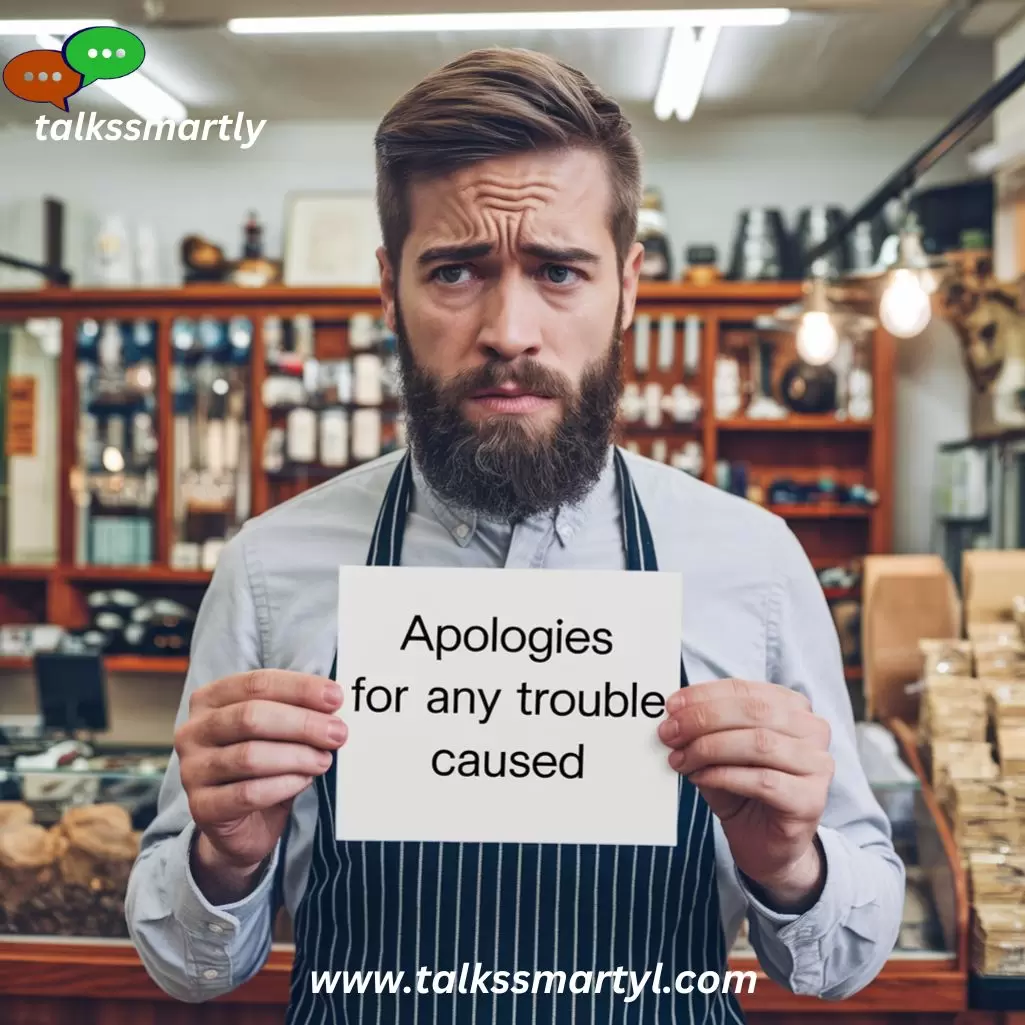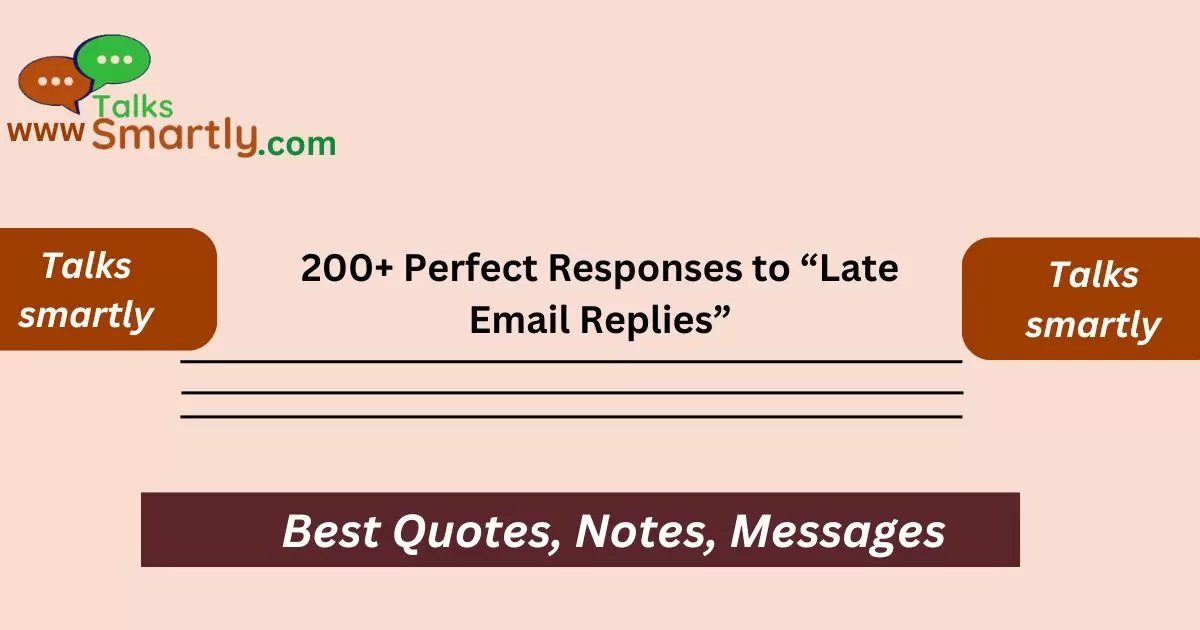“Timely email responses are essential for smooth communication, yet delays can occur. Handling these late replies effectively can enhance your professionalism.”
In today’s fast-paced world, email communication is key to our professional and personal lives. However, late email replies can often lead to frustration or misunderstandings. Addressing this issue effectively can help maintain professionalism and smooth communication.
When crafting your response, it’s important to balance understanding and assertiveness. You want to acknowledge the delay without coming across as overly critical or confrontational. This article provides a comprehensive list of 200+ responses to help you handle these situations with grace and professionalism.
Whether you’re replying to a colleague, a client, or a friend, finding the right words can make a significant difference. The following outlines offer practical responses for various scenarios, ensuring you can always find the perfect way to address a late reply.
Professional and Understanding Responses
- Thank you for your patience – I appreciate your understanding while waiting for my reply.
- Sorry for the delay – My apologies for the late response; I’ve been catching up on emails.
- I understand the delay – I completely understand how busy schedules can cause delays.
- Thanks for waiting – Thank you for waiting for my response; it’s much appreciated.
- Apologies for the late reply – I’m sorry for the delay in getting back to you.
- I’ve just seen your email – I just saw your email and wanted to reply as soon as possible.
- Delay due to high volume – I had a high volume of emails to address, and I’m catching up now.
- Thank you for your patience – Your patience while I caught up is greatly appreciated.
- Sorry for the inconvenience – Apologies for any inconvenience my delayed response may have caused.
- Delay due to unforeseen issues – I faced some unforeseen issues that caused a delay in my response.
- I’m back on track now – I’m now back on track and available to address any concerns.
- Appreciate your understanding – Thank you for your understanding regarding my late reply.
- Caught up now – I’ve caught up on my emails and wanted to get back to you promptly.
- Late but responsive – I’m responding now, though my reply is later than usual.
- Thanks for your patience – Thanks for your patience while I got back to you.
Casual and Friendly Responses
- Just saw your email – Hey! Just saw your email and wanted to get back to you.
- Better late than never – Sorry for the delay, but better late than never, right?
- Caught up now – I’m all caught up now; let’s chat!
- Late reply, but here – Sorry for the late reply, but I’m here now!
- Was swamped – I was swamped with work, but I’m here to respond now.
- Finally getting back – Finally getting back to you after a busy spell.
- A bit behind on emails – I was a bit behind on emails but wanted to reply now.
- Just catching up – Just catching up on my inbox and wanted to respond.
- Sorry for the hold-up – Apologies for the hold-up; I’m here to answer your questions.
- Long time, no email – Long time, no email! Here’s my response.
- My bad on the delay – My bad on the delay; I’m here now.
- Finally free to respond – Finally free to respond to your email!
- Sorry for the radio silence – Sorry for the radio silence; I’m back now.
- Took me a while – Took me a while, but I’m here to reply.
- Just now saw your message – Just now saw your message and wanted to get back to you.
Apologetic Responses
- I apologize for the delay – I sincerely apologize for the delay in responding.
- I’m sorry for the late response – I’m sorry for the late response; it wasn’t intentional.
- Apologies for not replying sooner – Apologies for not replying sooner; I had a lot on my plate.
- Sorry for the late reply – I’m sorry for the late reply and any inconvenience it caused.
- I regret the delay – I regret the delay in getting back to you and appreciate your patience.
- Sorry for my tardiness – Sorry for my tardiness in replying; it’s been a busy time.

- Apologies for any trouble caused – Apologies if my late reply caused any trouble or confusion.
- Sorry for the delay in getting back – Sorry for the delay in getting back to you; I’m catching up now.
- I didn’t mean to delay – I didn’t mean to delay my response and appreciate your patience.
- Apologies for the delay in my reply – Apologies for the delay in my reply; I’m here now.
- Sorry for the extended wait – Sorry for the extended wait; I’m available now.
- Regret not responding sooner – I regret not responding sooner and am addressing it now.
- I’m sorry for the delay – I’m sorry for the delay and any inconvenience it may have caused.
- My apologies for the wait – My apologies for the wait; thank you for your patience.
- Sorry for the late response – Sorry for the late response; I’ve been catching up on my emails.
Witty Replies to “I Like You”
Professional and Brief Responses
- Thank you for your patience – Thank you for your patience. Here’s my response.
- Sorry for the delay – Apologies for the delay. Let’s get to the matter at hand.
- I’m now available – I’m now available to address your concerns.
- Addressing your email now – I’m addressing your email now. Thank you for waiting.
- Delayed but responsive – Delayed but responsive. Let’s proceed.
- Thanks for your understanding – Thanks for your understanding. Here’s my response.
- I’m catching up now – I’m catching up now and have reviewed your email.
- Apologies for any inconvenience – Apologies for any inconvenience caused by the delay.
- Replying now – I’m replying now after a delay. Thank you for your patience.
- Brief delay – Brief delay in my response. Here’s the information you need.
- Thanks for waiting – Thanks for waiting. I’m here to respond now.
- Responding now – I’m responding now after the delay. Let’s move forward.
- My apologies – My apologies for the delay. Here’s my reply.
- Delayed response – Here’s my delayed response. Thanks for your patience.
- I’m available now – I’m available now to discuss the matter.
Formal Responses
- Thank you for your understanding – Thank you for your understanding regarding the delay.
- I appreciate your patience – I appreciate your patience as I address your email.
- I regret the delay in responding – I regret the delay in responding and appreciate your patience.
- Apologies for the late response – Apologies for the late response; I’m now available.
- Thank you for your patience and understanding – Thank you for your patience and understanding regarding my delayed reply.
- My sincere apologies for the delay – My sincere apologies for the delay; I am addressing it now.
- I’m sorry for any inconvenience caused – I’m sorry for any inconvenience caused by the delay in my response.
- Thank you for your patience – I thank you for your patience and understanding during this delay.
- I’m addressing this matter now – I’m addressing this matter now after a delay.
- Regret any inconvenience caused – Regret any inconvenience caused by the delay in my response.
- Apologies for any delay in communication – Apologies for any delay in communication. Here’s my response.
- Thank you for waiting – Thank you for waiting. I’m now prepared to respond.
- I appreciate your understanding – I appreciate your understanding regarding the delay in my reply.
- Responding to your email now – I am now responding to your email after a delay.
- Thank you for your patience during this time – Thank you for your patience during this time of delay.
Solutions-Focused Responses
- Here’s how I can help – Here’s how I can help address your concerns after the delay.
- Addressing your needs now – Addressing your needs now and ensuring this doesn’t happen again.
- Let’s resolve this – Let’s resolve this issue promptly after the delay.
- Providing solutions now – Providing solutions to your concerns following the delay.
- I’m here to assist – I’m here to assist you with the matter now.
- Ready to address your questions – Ready to address your questions and concerns now.
- Let’s move forward – Let’s move forward with resolving this matter.
- Here’s what we can do next – Here’s what we can do next after the delay.
- Working to resolve your issue – Working to resolve your issue and prevent future delays.
- Immediate action on this – Taking immediate action on your concerns now.
- Let’s discuss the next steps – Let’s discuss the next steps after my delayed response.
- Addressing your query now – Addressing your query now with a focus on resolution.
- Ready to assist – Ready to assist you now with your concerns.
- Providing a solution – Providing a solution to the issue at hand now.
- Let’s ensure this is resolved – Let’s ensure this is resolved efficiently despite the delay.
Encouraging Responses
- Looking forward to your reply – Looking forward to your reply and continuing our discussion.
- Excited to move forward – Excited to move forward after addressing this delay.
- Eager to get started – Eager to get started on the matter now.
- Let’s continue our discussion – Let’s continue our discussion and resolve any outstanding issues.
- Ready to dive in – Ready to dive into the matter now after the delay.
- Looking forward to your feedback – Looking forward to your feedback on the matter.
- Excited to collaborate – Excited to collaborate on this now that I’m back on track.
- Ready to tackle this – Ready to tackle this issue and move forward.
- Let’s get started – Let’s get started with the next steps after my delayed response.
- Looking forward to resolving this – Looking forward to resolving this matter with you.
- Eager to assist further – Eager to assist further now that I’ve caught up.
- Let’s make progress – Let’s make progress on this matter after the delay.
- Excited to continue – Excited to continue our work together now.
- Looking forward to your thoughts – Looking forward to your thoughts on this matter.
- Ready to engage – Ready to engage and address any concerns you have.
Short and Direct Responses
- Here’s my reply – Here’s my reply to your earlier email.
- Addressing this now – Addressing this now after a delay.
- Replying promptly – Replying promptly despite the delay.
- Immediate response – Immediate response to your email.
- Quick update – Quick update following my delayed response.
- Here’s what you need – Here’s what you need to know after the delay.
- Responding as promised – Responding as promised after the delay.
- Direct response – Direct response to your inquiry.
- Here’s the information – Here’s the information you requested.
- Updating you now – Updating you now with the necessary details.
- Replying now – Replying now with the information needed.
- Addressing the issue – Addressing the issue with a prompt response.
- Here’s my answer – Here’s my answer to your earlier question.
- Providing details now – Providing details now after the delay.
- Here’s the update – Here’s the update you’ve been waiting for.
Customer Service Responses
- Thank you for your patience – Thank you for your patience as I address your concern.
- Sorry for any inconvenience – Sorry for any inconvenience caused by the delay.
- We value your time – We value your time and are addressing your issue now.
- I’m here to help – I’m here to help with any concerns following the delay.
- Thank you for bringing this up – Thank you for bringing this up; I’m addressing it now.
- We appreciate your understanding – We appreciate your understanding regarding the delayed response.
- Apologies for the delay – Apologies for the delay; we’re working on your request now.
- Thank you for your patience – Thank you for your patience while we resolve this issue.
- We’re addressing this now – We’re addressing this now and appreciate your patience.
- Sorry for the wait – Sorry for the wait; we’re handling your request now.
- Thank you for your patience and feedback – Thank you for your patience and feedback; we’re on it.
- We’re working on it – We’re working on it now and appreciate your patience.
- Apologies for the delay in service – Apologies for the delay in service; we’re responding now.
- We’re here to assist – We’re here to assist with any issues following the delay.
- Thank you for your patience as we resolve this – Thank you for your patience as we resolve this matter.
Seeking Clarification Responses
- Need more details – I need more details to address your concern properly.
- Could you clarify – Could you clarify your previous message for me?
- More information needed – More information is needed to provide a complete response.
- Can you provide further details? – Can you provide further details on this matter?
- Seeking clarification – Seeking clarification on your previous email to assist better.
- Could you specify – Could you specify what you need help with?
- Need clarification on – Need clarification on the issue you mentioned.
- Further information required – Further information is required to address your concern fully.
- Can you elaborate? – Can you elaborate on your request so I can assist better?
- Clarify your needs – Clarify your needs so I can respond appropriately.
- Request for more details – Request for more details to resolve your issue.
- Could you explain further? – Could you explain further to help me understand better?
- Need more specifics – Need more specifics to address your query accurately.
- Further details needed – Further details are needed to respond to your email properly.
- Clarification needed – Clarification needed on the topic you mentioned.
Encouraging Future Communication Responses
- Looking forward to more updates – Looking forward to more updates and further discussion.
- Eager to continue our conversation – Eager to continue our conversation and address any concerns.

- Let’s keep in touch – Let’s keep in touch and ensure timely communication.
- Hoping for smoother communication – Hoping for smoother communication in the future.
- Looking forward to your next email – Looking forward to your next email and continued discussion.
- Eager to hear from you again – Eager to hear from you again and continue our dialogue.
- Let’s stay connected – Let’s stay connected and ensure timely responses moving forward.
- Looking forward to further updates – Looking forward to further updates from you.
- Hoping for better timing next time – Hoping for better timing in our future communications.
- Anticipating prompt responses – Anticipating prompt responses and smooth communication ahead.
- Let’s improve our response times – Let’s improve our response times for better communication.
- Looking forward to more efficient communication – Looking forward to more efficient communication in the future.
- Eager to continue our efficient exchange – Eager to continue our efficient exchange of information.
- Let’s ensure timely replies going forward – Let’s ensure timely replies going forward to avoid delays.
- Hoping for prompt responses next time – Hoping for prompt responses next time and smoother interaction.
Answer to key Question
1. What is a good way to apologize for a late email response?
A good way to apologize is to express genuine regret for the delay, acknowledge any inconvenience caused, and provide an explanation if appropriate. For example, “I’m sorry for the delay in my response. I was dealing with a high volume of emails and appreciate your patience.”
2. How can I address a late reply professionally?
Address a late reply professionally by thanking the recipient for their patience, briefly explaining the delay, and providing a clear response. For instance, “Thank you for your patience. I apologize for the delay in my reply due to unforeseen circumstances.”
3. What are some casual ways to handle late email replies?
Casual ways to handle late replies include acknowledging the delay with a light-hearted comment and quickly addressing the issue. For example, “Sorry for the delay! I finally got around to your email and here’s my response.”
4. How do I handle a late reply in customer service?
In customer service, acknowledge the delay, apologize for any inconvenience, and offer a solution or next steps. For instance, “Apologies for the delay in responding. We appreciate your patience and are now addressing your issue.”
5. What is the best way to request more information after a late reply?
Requesting more information after a late reply should be done clearly and politely. You might say, “Thank you for your patience. To better assist you, could you please provide more details on the matter?”
Conclusion
Handling late email replies can be challenging, but with the right approach, you can maintain professionalism and keep communication smooth. By choosing from the 200+ responses provided, you can find the perfect way to address any situation, whether it’s a professional or casual context.
Incorporating these responses into your communication strategy can help you manage delays more effectively and improve overall email interactions. Always strive for clarity and understanding, and you’ll navigate late replies with ease.












